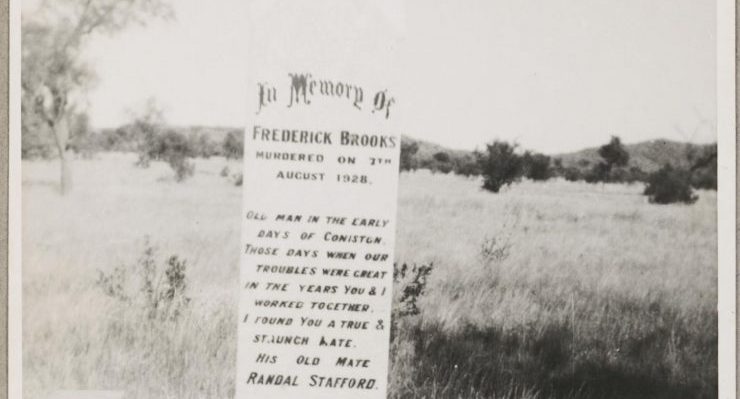
This is an edited extract from Michael Bradley’s book Coniston, published by UWA Publishing — out now.
“Be kind to the wild native if you want trouble. He mistakes kindness for fear all over Australia.” — F. Merlan in Aboriginal History (vol. 2)
Fred Brooks and Randal Stafford were old mates. The two archetypes of the Australian outback had met many years earlier while working on stations in the Innamincka country around Lake Eyre in South Australia. Stafford was a native South Australian, coming from a well-off family but having apparently gone bush at a young age. About Brooks’ background nothing is known. Both men were in their 60s in 1928.
Stafford had taken up the Coniston lease in 1917, and Brooks arrived there to help out sometime in the late 1920s. It seems that he had spent his whole adult life apart from white civilisation, working on outback stations, doing some prospecting, scraping an existence from the dirt. He had no family, money or ties. Most contemporary accounts call him “harmless”, although he was hardly helpless. He was a big man, 6’2 tall, toughened by vast experience of survival in the harsh extremes of Central Australia.
Conditions at Coniston were bad. Stafford was barely keeping things going, and he had no pay to offer his old mate. A few waterholes on the station were the only remaining decent water source in the region as the drought had run into its fourth year. As Stafford related the story a few years later, Coniston was becoming a dangerous place to be.
It was a bad drought year; and Harry Tilmouth from Napperby, and Nugget Morton from Anningie, had both taken out large mobs of cattle into the myall country on the Lander River [within Coniston’s boundaries]. Alice [Stafford’s Aboriginal partner who lived with him at Coniston] and my boys here often used to pass on to me threatening messages sent in by the myall blacks, telling us all to get out of their country and take our cattle away with us. Coniston Station is on the border between two different tribes, and the waterholes north west from here are a part of the territory of the Lander River myalls. Alice used to be very frightened whenever these messages came in; for the myalls had said they would kill her first.
Well, there was nothing to be done about it. Harry and Nugget stayed out there, and I sometimes killed an extra bullock for the camp blacks here so that they would not have to starve in the drought.
The “myall” or “bush blacks” Stafford was worried about were Aboriginal groups who so far had had little or no contact with white settlers and were considered by whites to be uncivilised and thus distinguished from so-called “camp” or “semi-civilised” Aboriginal people. Stafford may well have been receiving warnings as he said but, if so, they were coming from the local Warlpiri who were being pushed off the remaining water sources and were probably losing their patience.
When Brooks told Stafford he was going to head out from Coniston to do some dingo trapping, Stafford warned him that it would be too dangerous to venture any further out than a soak about 14 miles west of Coniston on the edge of the Tanami Desert, which Stafford had named Naval Action after a race horse he had once owned.
Brooks was unconcerned about the danger, telling Stafford that he’d lived with blacks all his life and could handle himself. So he set off, with plenty of provisions from Stafford. In Stafford’s words, what happened next had a tragic inevitability:
Now this is what happened — and it shows that one can never trust any of these bush blacks: their minds must work differently from ours. A party of myalls came in one night, and later came and asked him for some food. While Fred was giving it to them, they all jumped on him and attacked him. One of the gins held him by the hands, while some of the men hacked him down with their tomahawks. Then they stuffed his body down a rabbit burrow, and took all the stores from his camp.
So Stafford said. What was undeniably true about his story, which he started telling a few days after it happened and from which he never wavered, was that Fred Brooks had been clubbed to death by a small group of Aboriginal men. He had been camped at Yurrkuru for a few days, and a party of Warlpiri were also camping there, a few hundred yards or so distant. Early on the morning of 7 August, he was savagely attacked and killed, in an assault which was premeditated and without warning. His mutilated body was indeed shoved in a rabbit hole, his legs grotesquely sticking out in the air.
But why? The immediate question every white in Central Australia would want urgently answered was this: did he do something to provoke his murder — was it payback for a specific grudge — or had the much-feared native rising begun?








Another book I “must” buy! I have a query – “Stafford was a native South Australian coming from a well-off family”. Does this mean he was a White Australian born in South Australia and therefore “native”? I hope if he was a Black Australian he would not be called “Indigenous”.